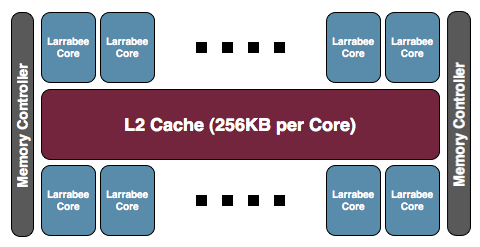Intel's Larrabee Architecture Disclosure: A Calculated First Move
by Anand Lal Shimpi & Derek Wilson on August 4, 2008 12:00 AM EST- Posted in
- GPUs
Putting it all Together - Return of the Ring Bus
Intel is keeping two important details of Larrabee very quiet: the details of the instruction set and the configuration of the finished product. Remember that Larrabee won't ship until sometime in 2009 or 2010, the first chips aren't even back from the fab yet, so not wanting to discuss how many cores Intel will be able to fit on a single Larrabee GPU makes sense.
The final product will be some assembly of a multiple of 8 Larrabee cores, we originally expected to see something in the 24-to-32 core range but that largely depends on targeted die size as we'll soon explain:

Intel's own block diagrams indicated two memory controller partitions, but it's unclear whether or not we should read into this. AMD and NVIDIA both use 64-bit memory controllers and simply group multiples of them on a single chip. Given that Intel's Larrabee will be more memory bandwidth efficient than what AMD and NVIDIA have put out, it's quite possible that Larrabee could have a 128-bit memory interface, although we do believe that'd be a very conservative move (we'd expect a 256-bit interface). Coupled with GDDR5 (which should be both cheaper and highy available by the Larrabee timeframe) however, anything is possible.
All of the cores are connected via a bi-directional ring bus (512-bits in each direction), presumably running at core speed. Given that Larrabee is expected to run at 2GHz+, this is going to be one very high-bandwidth bus. This is half the bit-width of AMD's R600/RV670 ring bus, but the higher speed should more than make up the difference.
AMD recently abandoned their ring bus memory architecture citing a savings in die area and a lack of need for such a robust solution as the reason. A ring bus, as memory busses go, is fairly straight forward and less complex than other options. The disadvantage is that it is a lot of wires and it delivers high bandwidth to all the clients on the bus whether they need it or not. Of course, if all your memory clients need or can easily use high bandwidth then that's a win for the ring bus.
Intel may have a better use for going with the ring bus than AMD: cache coherency and inter-core communication. Partitioning the L2 and using the ring bus to maintain coherency and facilitate communication could make good use of this massive amount of data moving power. While Cell also allows for internal communication, Intel's solution of providing direct access to low latency, coherent L1 and L2 partitions while enabling massive bandwidth behind the L2 cache could result in a much faster and easier to program architecture when data sharing is required.










101 Comments
View All Comments
phaxmohdem - Monday, August 4, 2008 - link
Can your mom play Crysis? *burn*JonnyDough - Monday, August 4, 2008 - link
I suppose she could but I don't think she would want to. Why do you care anyway? Have some sort of weird fetish with moms playing video games or are you just looking for another woman to relate to?Ooooh, burn!
Griswold - Monday, August 4, 2008 - link
He is looking for the one playing his mom, I think.bigboxes - Monday, August 4, 2008 - link
Yup. He worded it incorrectly. It should have read, "but can it play your mom?" :pTilmitt - Monday, August 4, 2008 - link
I'm really disappointed that Intel isn't building a regular GPU. I doubt that bolting a load of unoptimised x86 cores together is going to be able to perform anywhere near as well as a GPU built from the ground up to accelerate graphics, given equal die sizes.JKflipflop98 - Monday, August 4, 2008 - link
WTF? Did you read the article?Zoomer - Sunday, August 10, 2008 - link
He had a point. More programmable == more transistors. Can't escape from that fact.Given equal number of transistors, running the same program, a more programmable solution will always be crushed by fixed function processors.
JonnyDough - Monday, August 4, 2008 - link
I was wondering that too. This is obviously a push towards a smaller Centrino type package. Imagine a powerful CPU that can push graphics too. At some point this will save a lot of battery juice in a notebook computer, along with space. It may not be able to play games, but I'm pretty sure it will make for some great basic laptops someday that can run video. Not all college kids and overseas marines want to play video games. Some just want to watch clips of their family back home.rudolphna - Monday, August 4, 2008 - link
as interesting and cool as this sounds, this is even more bad news for AMD, who was finally making up for lost ground. granted, its still probably 2 years away, and hopefully AMD will be back to its old self (Athlon64 era) They are finally getting products that can actually compete. Another challenger, especially from its biggest rival-Intel- cannot be good for them.bigboxes - Monday, August 4, 2008 - link
What are you talking about? It's been nothing but good news for AMD lately. Sure, let Intel sink a lot of $$ into graphics. Sounds like a win for AMD (in a roundabout way). It's like AMD investing into a graphics maker (ATI) instead of concentrating on what makes them great. Most of the Intel supporters were all over AMD for making that decision. Turn this around and watch Intel invest heavily into graphics and it's a grand slam. I guess it's all about perspective. :)